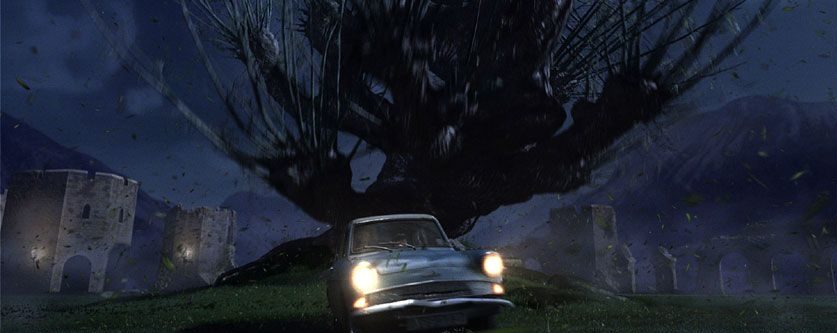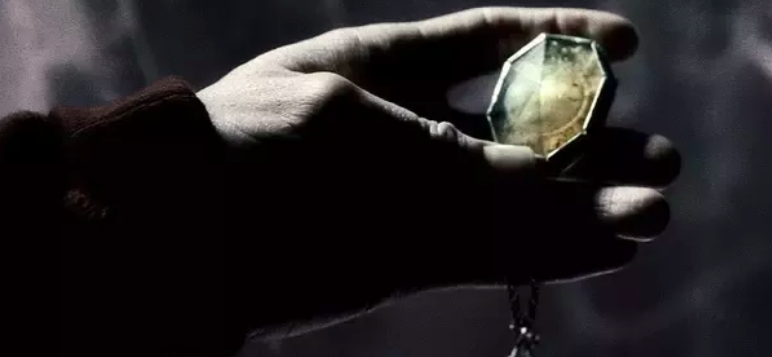Missed Opportunities in the Wizarding World: Sentient Objects
September 4, 2019—Over the course of a decade, JK Rowling delivered to us a famous story about a Boy Who Lived in 1,084,170 words. In case you missed that, the Harry Potter series includes well over a million words.
So I want to be clear at the outset of this 4-post blog series that I am not criticizing JKR for storytelling stinginess, and I am quite satisfied with how she chose to use those million+ words.
But as much as was included, much was left out. We all have unanswered questions. We’re all intrigued by aspects of her fictional world that could have been explored more. But there’s only so much a book series can relate.
So allow me to imagine that JK Rowling had had another million words to tell us her stories. How could the series have been shaped differently? What topics could have been developed more deeply? I present a few humble thoughts on how she could have used those extra million words.
Also, all posts will entirely disregard Cursed Child. You have been warned.
“Never trust anything that can think for itself if you can’t see where it keeps its brain.”
It’s one of those proverbs* that are handed down from parent to child in the Wizarding World, like “An apple a day keeps the doctor away” or “Good things come to those who wait.” It’s the sort of maxim that’s repeated so frequently that it becomes an ingrained (if ignored) part of a child’s psyche.
Arthur Weasley was particularly fond of this one, and he repeats it forcefully to his daughter Ginny in Chamber of Secrets, after she spends months communicating with Tom Riddle’s Diary, which goes on to possess her and Petrify several of her peers. Yet the Wizarding World is full of examples of objects that can think for themselves. So what can we learn about the Wizarding World by studying these objects?

Here’s a brief and by no means exhaustive list of things things without brains that can think for themselves in the Wizarding World:
- Horcruxes (particularly Riddle’s Diary and Slytherin’s Locket… see theory below): Obvious, but it needs to be said.
- Portraits: It’s made abundantly clear throughout the series that the portraits have personalities, thoughts, fears, and loyalties.
- The Marauder’s Map: Though the Map’s primary function is a mere reporting of people’s locations, it also “talks” to anyone who tries to open in without the password. It even recognizes Snape and comments on his life.
- Talking mirrors: True, comments like “Tuck your shirt in, scuffy!” (as the Weasleys’ mirror tells Harry in Chamber of Secrets) could be written off as enchantments designed to mortify recalcitrant children into being presentable. But the Leaky Cauldron mirror’s remark in Prisoner of Azkaban shows just a bit too much personality in too specific of a circumstance to be a spell-dictated reply: “You’re fighting a losing battle there, dear,” to Harry as he tries to flatten his hair.
- Arthur Weasley’s Ford Anglia: The flying car begins showing hints of personality early in Chamber of Secrets, ejecting Harry, Ron, and their possessions in revenge for being attacked by the Whomping Willow. It later becomes wild and takes on the behavior of an animal after living in the Forbidden Forest.
It strikes me that three of these five examples—Horcruxes, portraits, and the Map—are the results of people imprinting themselves in one way or another onto magical objects. In fact, the behaviors of all three mimic one another at various times and to various degrees.
More to the point, the wizards who craft these objects imprint themselves or others in three completely different ways, so there’s clearly more than one way to skin this particular goose (not that I recommend Horcruxes as a method of preserving oneself for posterity).
Why then, if it’s possible to leave one’s identity behind in a variety of different ways and objects, don’t we see a more intentional passing of the torch? So much wisdom and information could be passed down directly from original sources to future generations with just a little bit of planning, yet the only one in the entire series who seems to bother is Dumbledore, whose portrait manages to direct certain aspects of the war after the man’s death. Presumably, previous Headmasters and -mistresses prepare their portraits similarly, but as they are honor-bound to serve only their successors, such forethought is meaningless to the wider world.
Objects similar to the Marauder’s Map in particular would be an interesting educational tool. In this one piece of parchment, James Potter, Sirius Black, Remus Lupin, and Peter Pettigrew manage to enclose their teenage selves, having conversations with one another and with the person reading. So if such a thing is possible, wouldn’t it be interesting to put multiple personalities with differing viewpoints and backgrounds into one object and then allow them to interact with an observer and debate with one another? It would be like having a pocket-sized expert panel.

The other two objects I mentioned, the talking mirrors and the flying car, seem to have personalities entirely their own. The mirrors, while certainly serving a specific function, seem to be aware, so why couldn’t other mundane objects be imbued with a personality in a similar way? Imagine the magical equivalent of an AI-powered smart home, only with true intelligence and separate personalities for each component part.
On the other hand, the flying car’s behavior, which develops organically rather than by design (see theory below), is likened to that of a “large, turquoise dog” when it sees Ron for the first time in months in Chamber of Secrets. This presents the delightful possibility of magically saturated objects, given the space to grow into their own personalities, becoming loyal (and/or troublesome) companions to their owners.
Granted, magically animated objects should probably not be relied upon for extremely critical or sensitive matters, which is why this post doesn’t allude to war efforts or government uses. Only Dumbledore, the most powerful wizard alive with the advantage of the most powerful wand in existence, would entrust the fate of the world to his portrait (forgive his lack of seemly modesty).
But such objects could have dotted the landscape of the Wizarding World to a greater degree, adding yet more color, enrichment, and interest to already-breathtaking scenery.
*As a side note, I’ve always thought that Harry’s kids and Auror trainees would have been very familiar with “Your wand should never be further than your arm can reach” or something similar. Leaving their wands in the other room is, after all, the reason that his parents died without being able to put up a fight, as we see in Deathly Hallows.
Every post in this series will be accompanied by a pet theory of Taylor’s related to the post’s subject matter.
Theory: Objects become alive through constant contact with magic, while Horcruxes gain awareness through constant contact with other souls.
Objects become alive through constant contact with magic…
The first part of this theory is based mostly on Arthur Weasley’s flying Ford Anglia, as mentioned above. The car is the only object about which we’re told that becomes self-aware on accident. Arthur’s initial spellwork, by which he enhances its functions with multiple enchantments, along with the ambient magic of Hogwarts gives it life in a very real sense.
The books also hint that Hogwarts itself, loaded up to the gills with magic as it is, has some awareness, particularly in Deathly Hallows during the Battle of Hogwarts.
“He sprinted . . . ignoring the jets of light flying in the darkness all around him, and the sound of the lake crashing like the sea, and the creaking of the Forbidden Forest though the night was windless; through grounds that seemed themselves to have risen in rebellion, he ran faster than he had ever moved in his life . . .”
…while Horcruxes gain awareness through constant contact with other souls.

The second part of this theory is based on how wildly differently the Horcruxes behave from one another throughout the series. Riddle’s Diary, which spends almost a full year interacting directly with Ginny and Harry, becomes active verbally, physically, and magically, almost managing its own body eventually. Slytherin’s Locket, which was never even been interacted with directly, but merely worn around people’s necks, was able to drain Harry of some of his abilities (he couldn’t cast a Patronus after wearing it for too long in Deathly Hallows), perform some form of Legilimency on Ron, and then create manipulative magical illusions. We also know that the Horcrux inside Nagini is very active, using the snake’s body to scope out the Ministry in Order of the Phoenix and impersonate Bathilda Bagshot in Deathly Hallows for Voldemort. These three Horcruxes had had prolonged and intimate contact with humans.
Conversely, and despite the theatrics in the final movie, there’s no indication in the books that Ravenclaw’s Diadem, Hufflepuff’s Cup, or the Gaunt Ring (which had lain untouched for decades) are even aware that they are in danger before they are destroyed, much less fight back. (The curse that maims Dumbledore’s hand is a result of Voldemort’s protection around the Ring, not the Ring itself.)
Of course, if this theory’s true, then it would suggest that the sliver of Voldemort’s soul that resides inside Harry is always aware. It might seem a stretch to imagine that a piece of Voldemort wouldn’t reveal himself at some point if he’d spent over a decade in the mind of a child subject to neglect and abuse by Muggles. If nothing else, it would suggest a level of restraint he’s not known for.
But I believe that he would have come to the (fair) conclusion that if the Dursleys or later the Wizarding World at large ever learned of and investigated voices in Harry’s head, neither the soul shard nor Harry would be granted much time thereafter to regret their life choices. After all, world domination is all well and good, but Voldemort, at all times, is fueled by one superseding priority: self-preservation. And so he remains silent and unobtrusive in the mind of his greatest enemy.
On this evidence, I believe that the Horcruxes are dormant when left alone. It would explain how they are able to concoct elaborate schemes and manipulate with the best of them, even after decades with little to no outside stimuli. (Because, let’s face it, Voldemort is hardly the picture of stability to begin with. I can’t imagine what he’d be like after fifty years of solitary confinement.)
Only through continual contact with other human souls do Horcruxes regain awareness; thus, in some small way, Voldemort is reborn again.

